German Plum Cake (Zwetschgenkuchen)
This post may contain affiliate links. See my disclosure policy.
This authentic German Plum Cake recipe, known as Zwetschgenkuchen or Zwetschgendatschi, is made just the way you know and love it from Germany! A yeast-based cake with juicy plums and a sweet streusel topping, this extraordinarily delicious cake is one of my very favorites and is the way my Mutti and Oma made it!
For more fruity German cakes be sure to also try our German Apple Cake, Rhubarb Streusel Cake, and while not exactly “cake,” our Apple Strudel is a must!
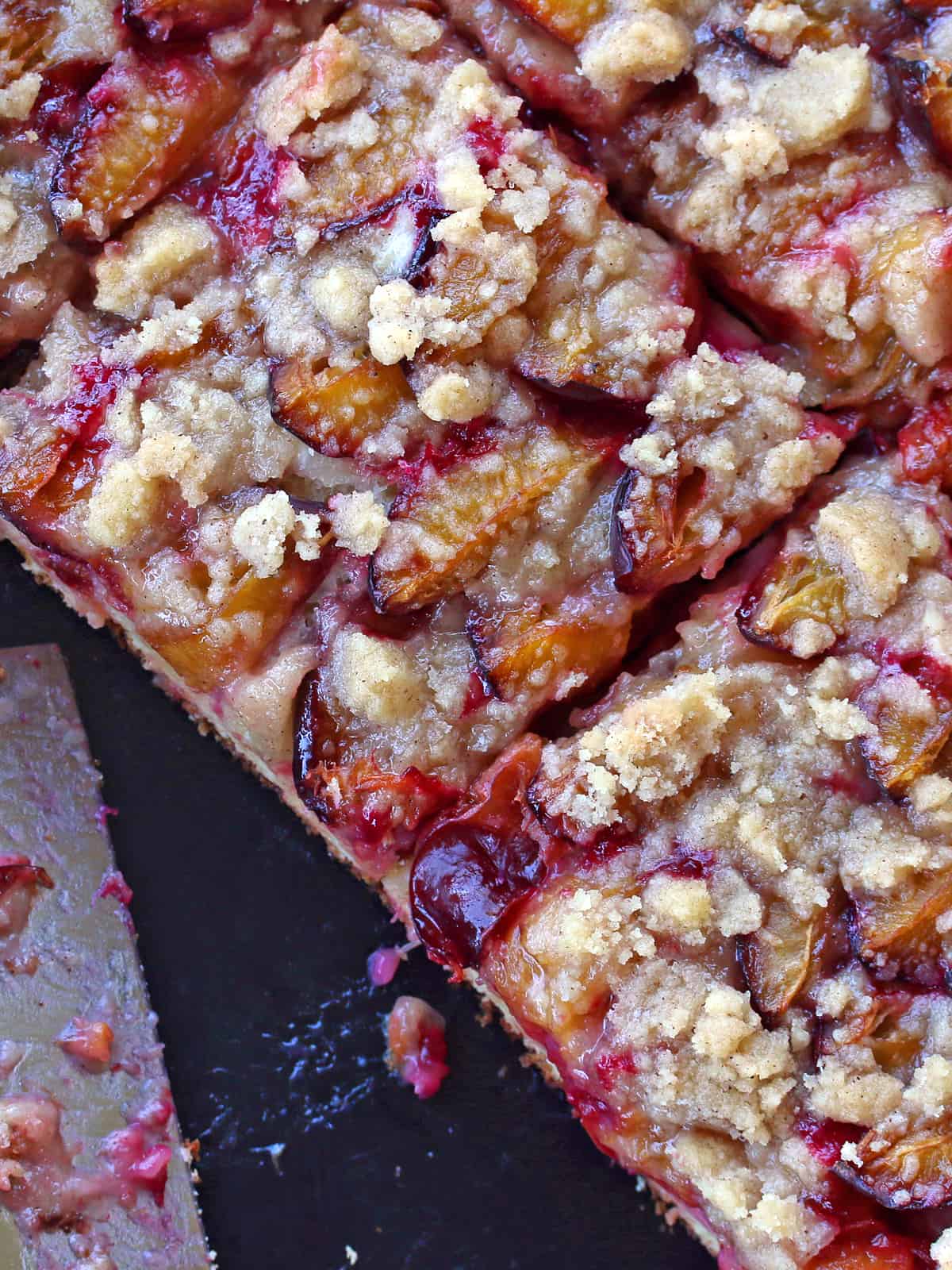
Depending on which region of Germany you’re in, German plum cake goes by a variety of names including Zwetschgenkuchen, Zwetschgendatschi, Quetschekuche or Pflaumenkuchen. I know, they’re all tongue-twisters! :)
Variations exist throughout the regions of Germany with some versions using a yeast dough while others use a shortcrust pastry known as Rührteig. Some have a streusel topping while others omit it. And some people make them round and taller while others make them rectangular in the style known as “Blechkuchen” (sheet pan cake). But whichever pastry crust is used, with or without streusel, and whether it’s round or rectangular, all of these versions showcase the plump, juicy, sweet European plums known as Italian plums.

Which Plums Do I Need to Make German Plum Cake?
To make proper German plum cake you really need Italian plums. These are small and oval-shaped and are far meatier than their Asian plum cousins. Fleshier with a lower moisture content is important because you want to have a moist cake, not a mushy cake. Italian plums are considered the most ideal for cooking and baking not only because of their texture but also because their flavor becomes more complex and delicious through cooking. Italian plum season is short, usually from September through early October, and Germans know how to seize the opportunity when it’s there. So wait patiently for plum season and then hit your local farmer’s markets for some Italian plums. Alternatively you can also use frozen Italian plums; just be sure to thaw and very thoroughly drain them before using them.
We were so lucky to have our own Italian plum trees when we lived in Washington State. When we moved to Virginia a few years ago we immediately got to work planting an orchard of fruit trees, including some Italian plums. They’re not yielding a lot of fruit yet, but they’re getting there and I’ll be ready for them!
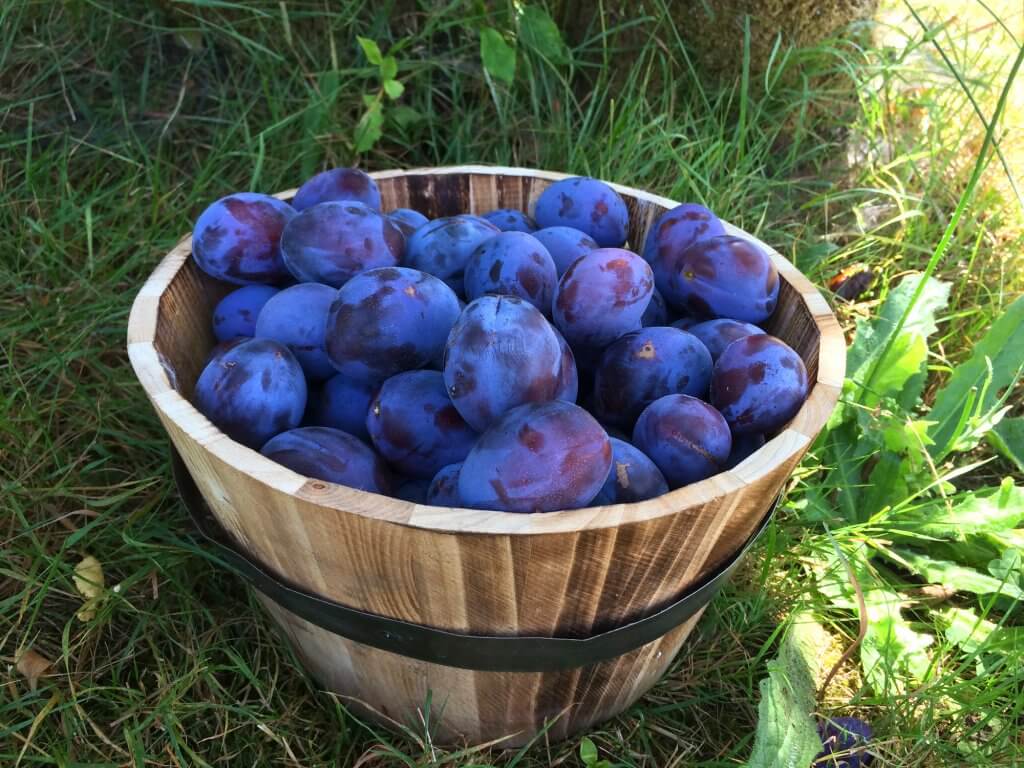
The version of German Plum Cake that we’re making today is my personal favorite. It’s made with yeast dough, which is more time-consuming than the simpler Rührteig (shortcrust pastry) versions, but it’s far superior in my opinion. This traditional version is also sprinkled with a streusel topping. This Zwetschgenkuchen recipe is the way my Mutti and Oma made it and is typical of where I’m from in Baden-Württemberg, though this version is popular throughout Germany. This type of Zwetschgenkuchen is typically made on a Backblech (a baking sheet) versus in a round springform and cut into squares for serving.
Like most German cakes, this German plum cake is not overly sweet. It has a nice balance between sweet and tart with just a touch of warmth from the cinnamon. The riper the plums the sweeter the cake will be.
This German plum cake will keep for 2-3 days. And although the streusel will get soft, the cake tastes even better the day after baking as the juices from the plums have time to penetrate the dough.
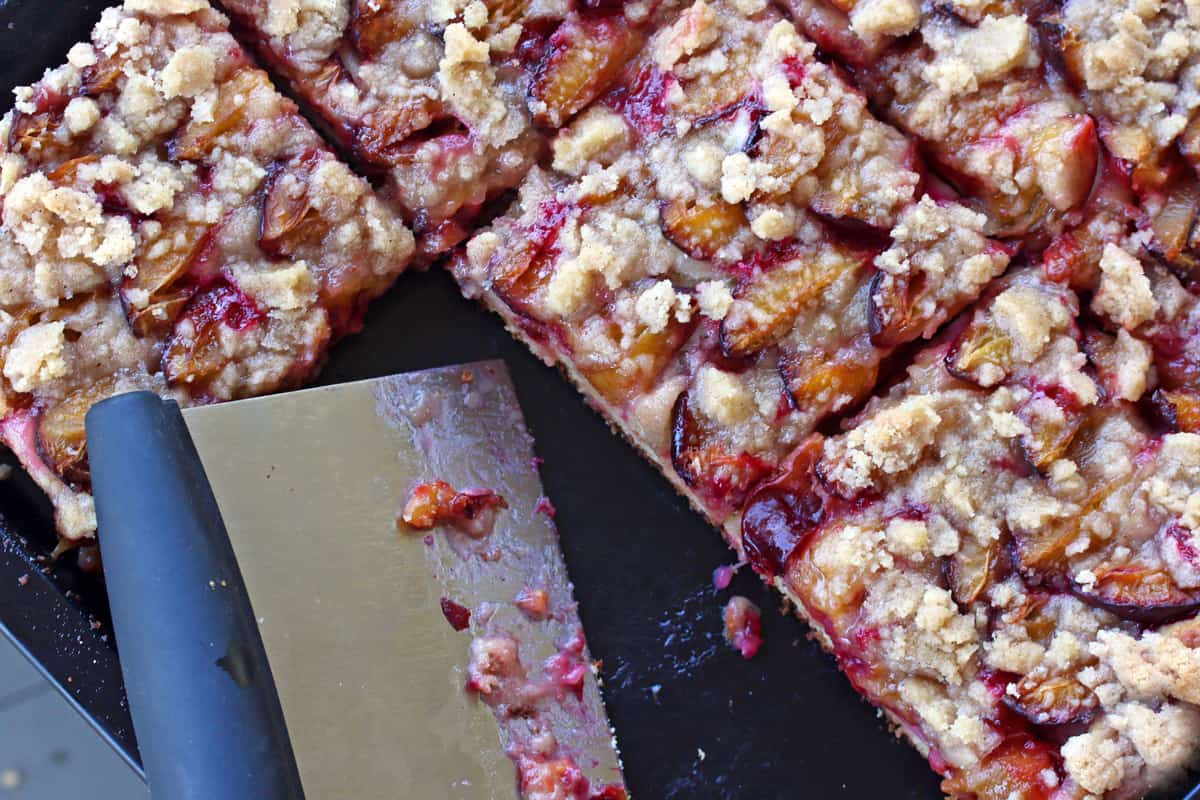
Can I Use Other Fruits?
You sure can! This recipe is also delicious using other stone fruits like apricots, peaches and nectarines.
Can You Freeze German Plum Cake?
Yes, you can. I generally recommend eating it within a couple of days but if you have more leftovers than you can manage, this can be wrapped and put in a freezer container for up to a month. Let it thaw in the fridge overnight.
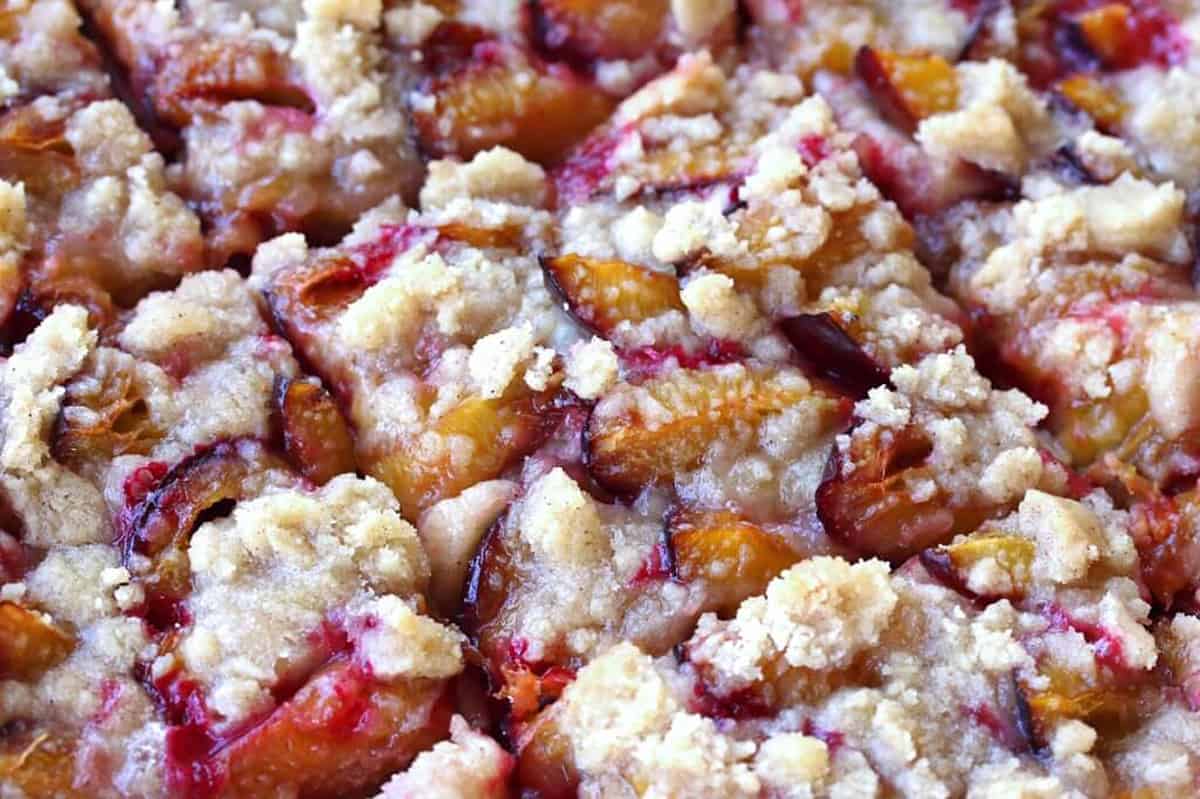
German Plum Cake Recipe
Let’s get started!
Dissolve the yeast into the warm milk and let is sit for 5-10 minutes until frothy.
Place the flour, sugar and salt in the bowl of a stand mixer and pour in the yeast mixture, melted warm (not hot) butter, eggs and vanilla extract. Give it an initial stir to combine the ingredients and then attach a dough hook and knead it on the bread setting (“2”) for 4-5 minutes.
The dough will be sticky but should hold together fairly well. It will not be firm enough to knead into a ball, think of it more as a thick batter.
Cover it loosely with plastic wrap and set it in a warm, draft free place to rise for an hour or until about doubled in size.
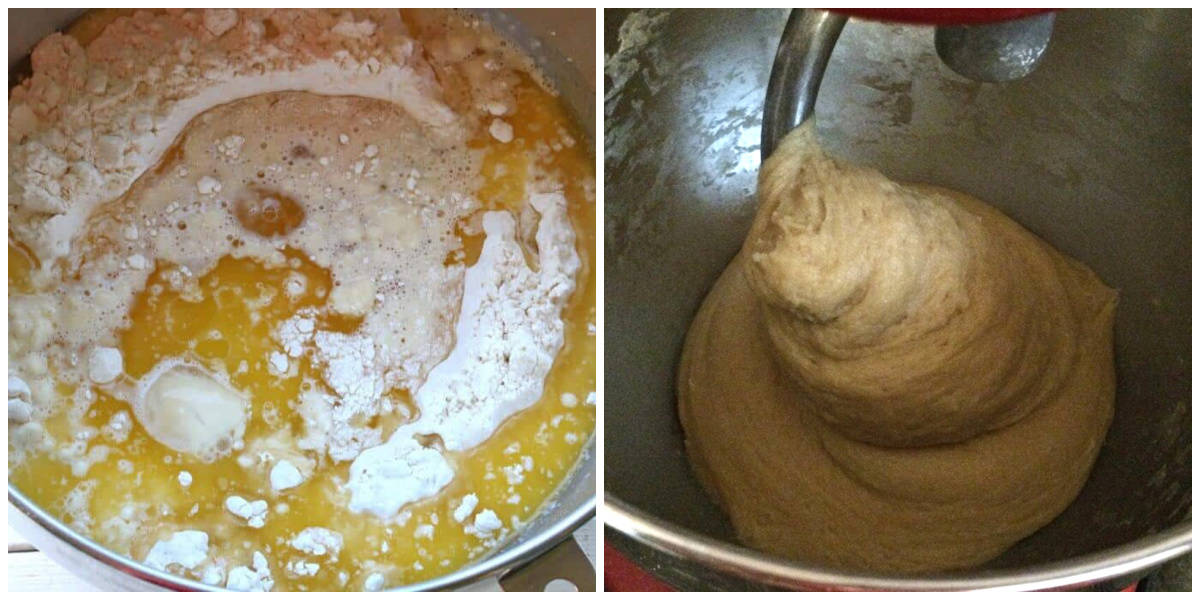
Generously butter a large jelly roll pan (at least 18 inches in length and about 13 inches wide) or, like I’m using and as pictured below, a German Backblech if you have one (the one I’m using in the picture I brought with me from Germany).
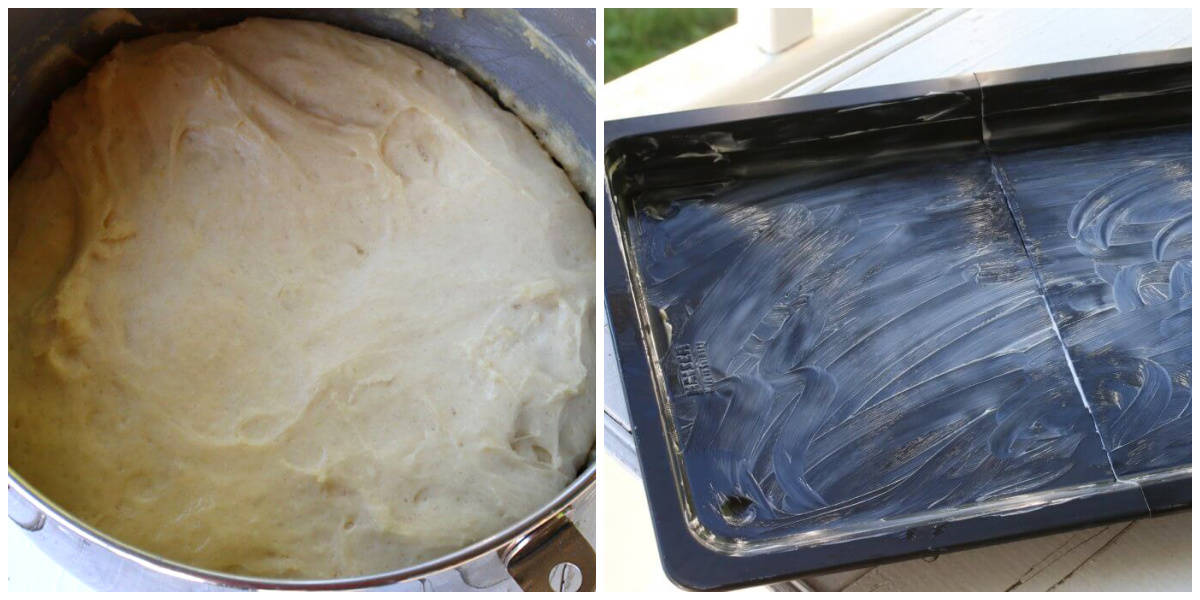
Use your hands to spread the dough out across the full length of the pan, pressing it up against the sides. It’s yeast dough so it will resist, but just keep pushing it back into position the best you can. Once you put the plums on it, those will help keep it in place.
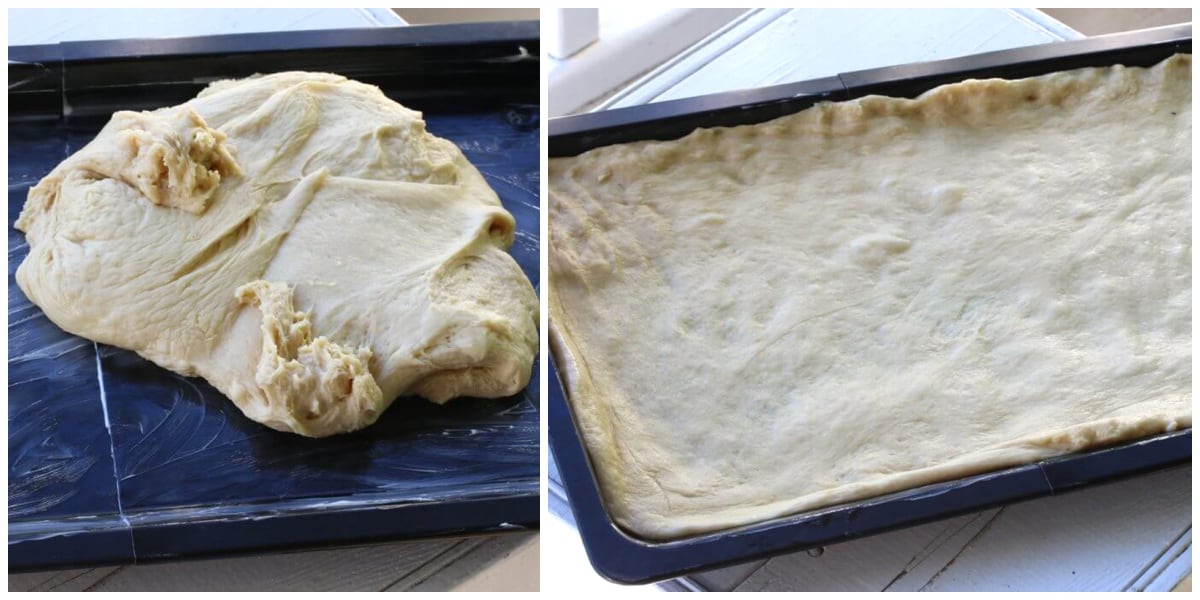
Time for the plums! The riper the plums the sweeter the cake will be. However, if they’re overly ripe – meaning mushy – they’ll be even mushier on the finished baked product, so keep that in mind too.
Cut the plums in half and remove the pits. Then slice the plums in half again, slicing each plum into quarters.
Lay the plums close together in rows over the whole length of the dough on the sheet pan.
If you want your cake a bit sweeter you can sprinkle it *lightly* with sugar or cinnamon-sugar if you prefer more cinnamon. I emphasize “lightly” because the more sugar you add the more watery the cake will be as the sugar liquifies during baking and your streusel will also “melt” in contact with it.
Set the pan in a warm place and let it rise for up to another hour.
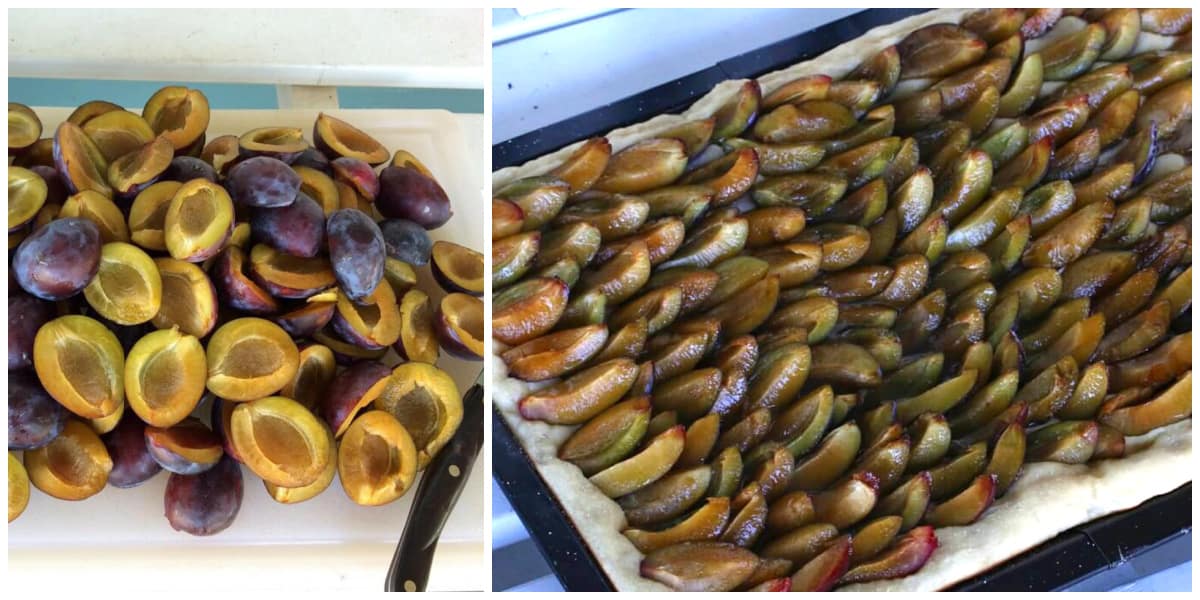
Now let’s make the streusel topping. Place all the ingredients in a medium-sized bowl and use your fingers to bring it all together. Work with the mixture until it’s thoroughly combined and forms a rough sand and clumpy texture.
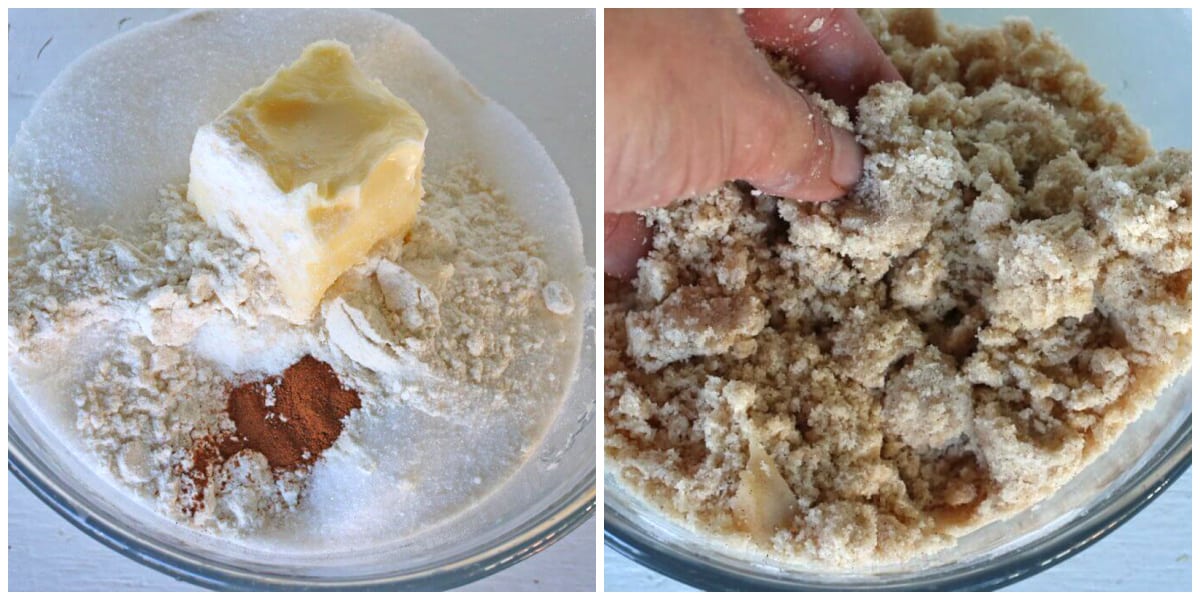
Sprinkle the streusel over the top of the cake.
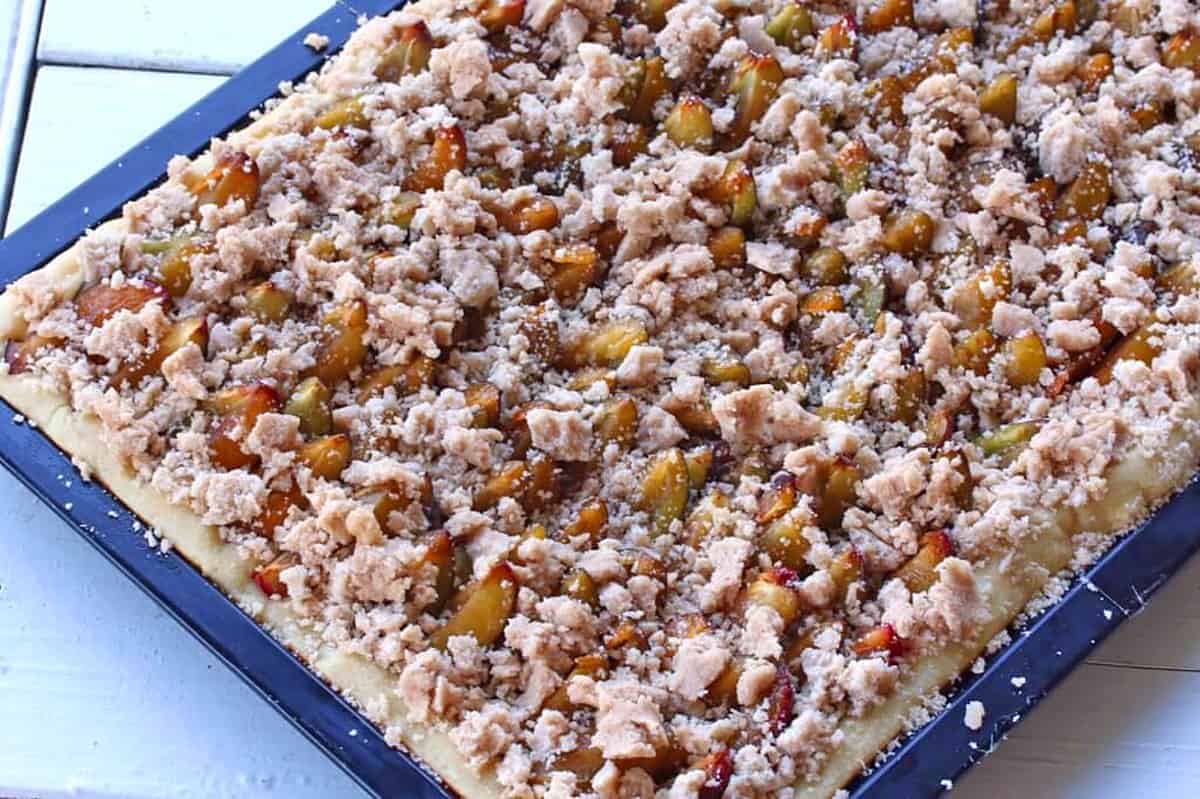
Bake the cake on the middle rack of the oven preheated to 350 degrees for 30-35 minutes or until the top is golden.
Let the cake sit for at least 10 minutes before slicing to let some of the liquid set.

Slice the cake into squares.
A tool that I use that’s really handy and works like a charm for sheet cakes and many other things is the OXO Multi-Purpose Scraper & Chopper.
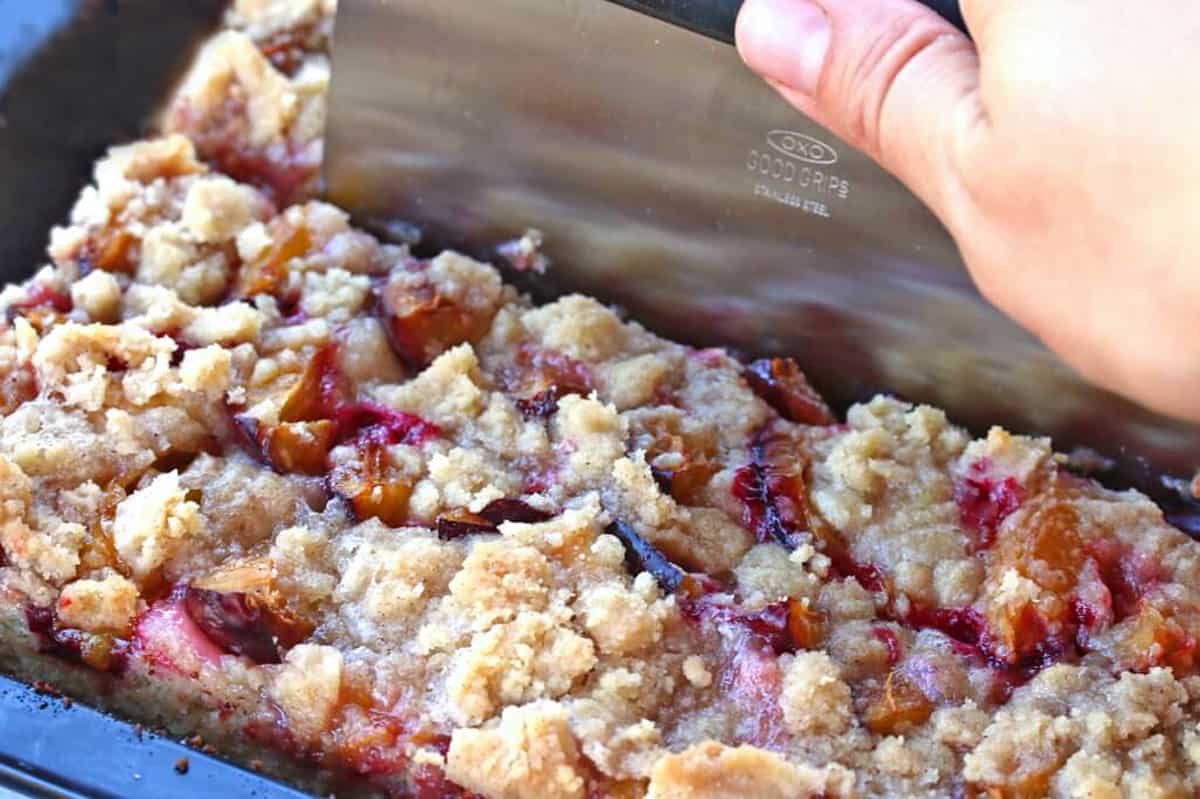
Serve and enjoy!
Guten Appetit!

For more delicious German desserts be sure to try our:
- German Apple Cake
- German Cheesecake
- Berliner
- Dampfnudeln
- Germknödel
- Cherry Marzipan Streusel Cake
- Gugelhupf
- Stollen
- Rhubarb Streusel Cake
- Pfeffernüsse
- Lebkuchen
- Zimtsterne
Save This Recipe
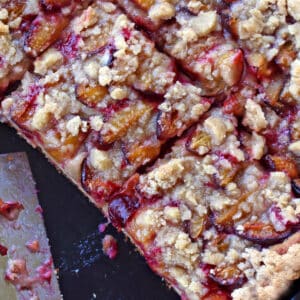
German Plum Cake (Zwetschgenkuchen)
Ingredients
- 3 + pounds Italian plums ,cut into quarters, pits removed
- 1 cup warm milk , *start with 3/4 and add extra to the dough as needed
- 1 1/2 tablespoons dry active yeast
- 4 cups all-purpose flour
- 3/4 cup sugar
- 1/2 teaspoon salt
- 1 stick butter (1/2 cup melted but not hot)
- 2 eggs
- 1 teaspoon quality pure vanilla extract
- For the Streusel:
- 1 cup all-purpose flour
- 1 cup sugar
- 1 teaspoon ground cinnamon
- 1/2 cup butter ,at room temperature
Instructions
- Dissolve the yeast into the 3/4 cup warm milk and let is sit for 5-10 minutes until frothy.
- Place the flour, sugar and salt in the bowl of a stand mixer and pour in the yeast mixture, melted warm (not hot) butter, eggs and vanilla extract. Give it an initial stir to combine the ingredients and then attach a dough hook and knead it on the bread setting ("2") for 4-5 minutes, adding the remaining 1/4 cup milk as necessary. (The dough will be sticky but should hold together fairly well. It will not be firm enough to knead into a ball, think of it more as a thick batter.) Cover it loosely with plastic wrap and set it in a warm, draft free place to rise for an hour or until about doubled in size.
- Generously butter a German Backblech extended to full length or a large jelly roll pan (at least 18 inches in length and 1 inch sides but even then the crust will be thicker than with the Backblech).
- Use your hands to spread the dough out across the full length of the pan, pressing it up against the sides. (It's yeast dough so it will resist, but just keep pushing it back into position the best you can. Once you put the plums on it, those will help keep it in place.) Lay the plums close together in rows over the whole length of the dough on the sheet pan. (If you want your cake a bit sweeter you can sprinkle it *lightly* with sugar or cinnamon-sugar if you prefer more cinnamon. I emphasize "lightly" because the more sugar you add the more watery the cake will be as the sugar liquifies during baking and your streusel will also "melt" in contact with it.)
- Set the pan in a warm place and let it rise for up to another hour.
- To make the streusel: Place all the ingredients in a medium-sized bowl and use your fingers to bring it all together. Work with the mixture until it's thoroughly combined and forms a rough sand and clumpy texture. Sprinkle the streusel over the top of the cake.
- Bake the cake on the middle rack of the oven preheated to 350 degrees for 30-35 minutes or until the top is golden.
- Let the cake sit for at least 10 minutes before slicing to let some of the liquid set. Slice the cake into squares and serve.
Notes
Nutrition
Originally published on The Daring Gourmet September 8, 2016



















Thank you so much for sharing this recipe! I made this today for a special breakfast for my son and daughter-in-law who are visiting, they loved it! It was absolutely delicious and beautiful! I used a combination of plums and apricots from our trees that I had on hand. It was really great with dollop of whipped cream on it as well:) *Also, a helpful note: I did 3/4 of the recipe and cooked it in a 15 x 11 jelly roll pan, It turned out perfectly:)
That’s wonderful, Missy, I’m so happy they enjoyed it and I really appreciate the feedback, thank you!
Thank you for the recipe. my sister and I remember our oma making bread for us. Our favorite had little chunks of pumpkin in it. Have you heard of this? We were very young children and we don’t really know how accurate our memories are but I am the cook in the family and my sister keeps urging me to find a recipe like this. Oma was from Hamburg. I know that regions are very diverse in Germany especially where traditional memories are concerned. . Hopefully you can help me with this .
Hi Mo, yes, Hamburg is in north Germany and that region was traditionally known for pumpkin bread. In German it’s called Kürbisbrot. During harvest season in the autumn the pumpkins and a variety of winter squash would be harvested, pureed (sometimes roasted) and then baked in bread. I haven’t specifically seen varieties with chunks of pumpkin in it but that’s certainly very possible and instead of pureeing all of the pumpkin you could leave some of it in chunk form to add to the dough. Here are just a couple of examples of many recipes you can find online and at the top of your screen (in Chrome) in the url search bar you can click on the translate button and it will translate the recipes into English for you: https://www.chefkoch.de/rezepte/343983785828/Kuerbisbrot.html. And another: https://www.einfachbacken.de/rezepte/kuerbisbrot-einfach-selber-machen. Type “Kürbisbrot Rezept” into your search engine and you’ll find a lot of recipes to choose from. I hope this helps!
My mother is from Stuttgart and loves this recipe. I’m just wondering about the 2 1/2 tablespoons of yeast to the flour proportions. Is that accurate? Thank you.
Hi Charmaine, I’m so glad to hear that! It’s 1 1/2 tablespoons and yes, that’s correct.
Hi Kim, just found your blog and it mouth is watering…. My mother and father made most of your recipes and I’m getting so excited that I finally found them. Both my parents are passed and trying to figure out the recipes my mom used to make is difficult. The roladan, bread dumplings, Rotkohl, mmmmmm. My mother made a dish with cabbage and ground beef that had a sweet taste to it and also caraway seeds?? Any idea what that would have been ?? Hoping to find it again.
Thank you so much, Doris <3 Yes, the dish you're describing is one that my Mutti as well and one that I continue to make in our family. It's a nice low-carb meal and when I make it for my kids I'll often serve it with a slice of homemade crusty sourdough bread, perfect for mopping up the flavorful juices. Here's a recipe for it that's basically the same way that I make it, you can click the translate option at the top your browser to translate the recipe into English if you need to: https://www.kochbar.de/rezept/506696/Weisskohl-Hackfleisch-Topf.html. Happy cooking! :)
Rookie here.Don’t have a stand mixer. Will a hand mixer do?
Hi Diana, most hand mixers aren’t powerful enough to knead dough. If yours is specifically made to do that then absolutely. Otherwise you can simply knead the dough by hand on a lightly floured surface, about 8-10 minutes.
Thank you for sharing all of these wonderful recipes, especially this one. They remind me of my Oma and taste like hers!
Thank you so much for the compliment, Shiloh, I appreciate it! <3
This was absolutely scrumptious! This brought back memories of visiting my Oma and tasted as good or better than I remembered.
Oh I’m so glad, Teresa, thank you very much!
Kimberly, this is truly something extra special. I can’t tell you how this made my day. It brought back so many memories of the Zwetschgenkuchen my Oma always made for us. I can’t thank you enough for this wonderful recipe, thank you.
Ursula, I am so happy that you enjoyed this and that it was a nostaglic walk down memory lane for you. Thank you so much for the feedback!